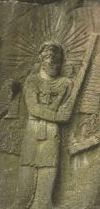Tomorrow’s World, “Christmas: Harmful for Children?”
The current issue of LCG’s Tomorrows World magazine has the following in an article by its Rod McNair titled “Christmas: Harmful for Children?:
Saturnalia’s Dark Echoes
Author Hugo Slim reminds us that Christmas “is perhaps the best example of the early Church Christianizing the traditional non-Christian festivals of a season—in this case the festivals of returning light surrounding the winter solstice” (A Feast of Festivals, pp. 36–37). The Romans celebrated the solstice season as the “Saturnalia, honoring Saturn, the god of agriculture” (Fillmore, p. 10).
This connection to the Saturnalia reveals an even darker side to Christmas traditions, and shows plainly why Christmas is not a child-friendly holiday! The Encyclopaedia Britannica explains that at the feast of Saturnalia, “all classes exchanged gifts, the commonest being wax tapers and clay dolls. These dolls were especially given to children…” (article: “Saturnalia,” 11th edition). What was the purpose of those gifts? “Varro thought these dolls represented original sacrifices of human beings to the infernal god. There was, as we have seen, a tradition that human sacrifices were once offered to Saturn, and the Greeks and Romans gave the name of Cronus and Saturn to a cruel Phoenician Baal, to whom, e.g. children were sacrificed at Carthage” (ibid.).
Child Sacrifice and Cannibalism?
Saturnalia—the festival Christmas absorbed—even carries echoes of ancient child sacrifice! It sounds horrific that dolls were given as gifts as symbols or proxies of children burnt to pagan gods. Yet this practice echoes the modern tradition of hanging cherubs or human figures on Christmas trees! The ancient Greeks placed small masks called oscilla on branches, where they could twirl freely in the wind. Encyclopaedia Britannica explains that oscilla were small figures, most commonly masks or faces, that were hung up “as offerings to various deities.… The custom of hanging these oscilla represents an older practice of expiating human sacrifice” (ibid.).
Not only did ancient Saturn-worship and fire-worship involve child sacrifice, it also included cannibalism. Author John Garnier noted: “Cannibalism appears to have been initiated by Cronus, i.e. Saturn… For we are told by Sanchoniathon that Cronus was the originator of human sacrifices… Saturn is represented as devouring his own children.” (The Worship of the Dead, pp. 34–35).
When “Christian” missionaries turned a blind eye to the symbols of ancient pagan festivals observed by their converts, they absorbed into their own worship and practice a number of ancient rites that echoed child sacrifice and cannibalism. Symbols of these abominable practices are still extant today as grim reminders of the “dark side of Christmas!”
When the ancient Israelites entered Palestine, they encountered a people who worshiped the god Moloch, the precursor of Saturn and Kronos…Though God forbade His people from following the Canaanites’ example, they slid into this morbid practice: “They even sacrificed their sons and their daughters to demons, and shed innocent blood, the blood of their sons and daughters, whom they sacrificed to the idols of Canaan” (Psalm 106:37–38).
Would God want you to observe traditions that contain trappings of child-sacrifice and fire-worship? Would God want you to teach your children beliefs that obscure the real God and instead focus on myths and fables? Would He want you to participate in traditions that are blatantly materialistic?
http://www.tomorrowsworld.org/cgi-bin/tw/tw-mag.cgi?category=Magazine51&item=1193929572
——————————————————————
In the fourth century the Catholic historian Eusebius reported that humans., including children, were sacrificed annually for Saturn:
For what can be a greater proof of madness, than to offer human sacrifice, to pollute every city, and even their own houses, with kindred blood? Do not the Greeks themselves attest this, and is not all history filled with records of the same impiety? The Phœnicians devoted their best beloved and only children as an annual sacrifice to Saturn. The Rhodians, on the sixth day of the month Metageitnion, offered human victims to the same god…At Heliopolis three victims were daily offered to Juno, for whom king Amoses, impressed with the atrocity of the practice, commanded the substitution of an equal number of waxen figures. In Chios, and again in Tenedos, a man was slain and offered up to Omadian Bacchus. At Sparta they immolated human beings to Mars. In Crete they did likewise, offering human sacrifices to Saturn…
Diodorus, the epitomizer of libraries, affirms that two hundred of the noblest youths were sacrificed to Saturn by the Libyan people, and that three hundred more were voluntarily offered by their own parents (Eusebius. Oration in Praise of Constantine Pronounced on the thirtieth anniversary of his reign. Chapter 13, Verses 7,8).
Notice that Eusebius is actually condemning not only Saturn sacrifices, but the use of substitution with human made figures.
Essentially the Christmas-New Year’s season run for most of December until January 1st. Modern observances basically coincide with the dates of the old Saturnalia, Mithra, and New Year’s celebrations.
Of course, many do know that the reason that December 25th was chosen was because that was the birthday of Mithra, the sun-god. Here is a carving of Mithra:

This radiating from the head ultimately ended up in painting, etc. of Greco-Roman saints. And this is part of why people started to equate the “Son of God” with the “God of the Sun” (even though the words for son/sun in Greek and Latin do not sound the same like they do in English).
Three articles of possibly related interest may include:
What Does the Catholic Church Teach About Christmas and the Holy Days? Do you know what the Catholic Church says were the original Christian holy days? Was Christmas among them?
Is January 1st a Date for Christians Celebrate? Historical and biblical answers to this question about the world’s New Year’s day.
Sunday and Christianity Was Sunday observed by the apostolic and true post-apostolic Christians? How clearly endorsed Sunday?
 |
Tweet |
|